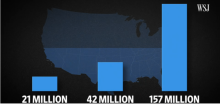A recent Wall Street Journal (WSJ) article (requires subscription) chronicles the increasingly problematic effect of data caps on the quality of residential subscribers' Internet access experience.
Also known as a bandwidth cap, a data cap is a monthly bandwidth usage limit Internet Service Providers (ISPs) sometimes impose on subscribers at their standard monthly rates. While some ISPs charge customers more for exceeding their monthly bandwidth caps, in other cases ISPs may even cut off a customer’s service completely.
The problem is also harming companies like Netflix and Sling TV who are losing customers who can’t justify paying for a high capacity video streaming service that’s only available until they hit their data caps partway through the month. In response, Netflix lowered the video quality for users on ISP networks that use data caps as a way to help them avoid the limitations. The plan worked, but in the process Netflix angered customers, who blamed both the ISPs and the streaming service for the lowered video quality.
It's Not All About The Money
The problem goes beyond the extra fees charged to customers who use a lot of data. The WSJ article cites two Internet users who’d like to join the growing number of “cord cutters” who are dropping television service for Internet-based video. As one man put it:
“I wouldn’t have regular TV if not for the data cap,” he says. “Comcast has got me by the throat.”
Another added:
“I was planning to cut the cord when my DirecTV contract is up,” he says. “This is essentially a ploy to keep people from cutting cable in my opinion.”
An increasing number of subscriber complaints and suspicions about the accuracy of measuring bandwidth usage heighten concerns.
Feds Take Notice



